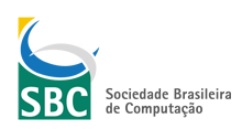Proposta de uma Ontologia para Representar e Gerenciar Emoções em Agentes
Resumo
Este artigo realiza uma análise de diversos modelos de emoções, oriundos da psicologia, utilizados para representar emoções em agentes. Esta análise serve como base para o desenvolvimento de uma proposta de ontologia para representar e gerenciar emoções em agentes de interface que podem ser aplicados em ambientes colaborativos.Referências
Goméz-Peréz, A., Fernández-Lópes, M; Corcho, O. (2004) Ontological engineering: with examples from the areas of knowledge management, e-commerce and the semantic web. London: Springer.
Bates, J. (1992) The Nature of Characters in Interactive World and The OZ Project. Technical Report CMU-CS-92-200 – Carnegie Mellon University Straker, D. Basic emotion, [link] (15/10/2005)
Breese, J. e Ball, C. (1998) Modelling Emotional State and Personality for Conversational Agents. Technical Report MSR-TR-98-41 – Microsoft Research.
Buisine, S., Abrilian, S. & Martin, J.C. (2004). Evaluation of Multimodal Behaviour of Embodied Agents. In Ruttkay, Z., & Pelachaud, C. (Eds.), From Brows to Trust (pp. 217-238). The Netherlands: Kluwer Academic Publishers.
Egges, A.; Kshirsagar, S.; Magnenat-Thalmann, N. (2003). A Model for Personality and Emotion Simulation. Knowledge-Based Intelligent Information & Engineering Systems.
Ekman, P. (1992) Telling Lies: Clues to Deceit I the Market Place, Politics and Marriage. New York: Norton.
Ekman, P. Basic Emotions. 1999 [link] (10/10/2005)
Garcia-Rojas, A.; Vexo, F.; Thalmann, D.; Raouzaiou, A.; Karpouzis, K.; Kollias, S. (2006) Emotional Body Expression Parameters In Virtual Human Ontology. In Workshop on Shapes and Semantics, Matsushima, Japan, pp. 63-70
Gratch, J., & Marsella, S. (2001). Tears and Fears: Modelling Emotions and Emotional Behaviors in Synthetic Agents. In International Conference on Autonomous Agents and Multiagents Systems (pp. 278-285). Montreal: ACM Press.
Gulz, A., & Haake, M. (2006). Design of animated pedagogical agents: A look at their look. International Journal of Human-Computer Studies, 64, 322-339.
Kort, B., Reilly, R., Picard, R. W. (2001) An Affective Model of Interplay Between Emotions and Learning: Reengineering Educational Pedagogy-Building a Learning Companion. In Proceedings of IEEE International Conference on Advanced Learning Technologies. Madison.
Lester, J., Towns, S., Callaway, C., Voerman, J., & FitzGerald, P. (2000) Deictic and Emotive Communication in Animated Pedagogical Agents. In J. Cassell, S. Prevost, J. Sullivan, and E. Churchill (Eds.) Embodied Conversational Agents (pp. 123-154). Cambridge: MIT Press.
Lester, J.; Voerman, J. L.; Towns, S. G.; e Callaway, C. B. (1997) Cosmo: A life-like animated pedagogical agent with deictic believability. In: Proceedings of the IJCAI97 Workshop on Animated Interface Agents: Making them Intelligent, Nagoya.
Ortony, A., Gerald C. e Collins A. (1988). Cognitive Structure of Emotions. Cambridge University.
Paiva, A., Dias, J., Sobral, D., Aylett, R., Woods, S., Hall, l., & Zoll, C. (2005). Learning by Evoking Empathy with Synthetic Characters. Applied Artificial Intelligence, 19, 235-266.
Pinto, H e Paiva, A. Ontologia de Teorias de Emoções. [link] (11/01/2007)
Plutchik, R. (1994) The Psychology and Biology of Emotion. New York: Harper Collins College Publishers.
Triezenberg, K. (2005) The Ontology of Emotion, Thesis Doctor of Philosophy, CERIAS Technical Report 2005-71.
Bates, J. (1992) The Nature of Characters in Interactive World and The OZ Project. Technical Report CMU-CS-92-200 – Carnegie Mellon University Straker, D. Basic emotion, [link] (15/10/2005)
Breese, J. e Ball, C. (1998) Modelling Emotional State and Personality for Conversational Agents. Technical Report MSR-TR-98-41 – Microsoft Research.
Buisine, S., Abrilian, S. & Martin, J.C. (2004). Evaluation of Multimodal Behaviour of Embodied Agents. In Ruttkay, Z., & Pelachaud, C. (Eds.), From Brows to Trust (pp. 217-238). The Netherlands: Kluwer Academic Publishers.
Egges, A.; Kshirsagar, S.; Magnenat-Thalmann, N. (2003). A Model for Personality and Emotion Simulation. Knowledge-Based Intelligent Information & Engineering Systems.
Ekman, P. (1992) Telling Lies: Clues to Deceit I the Market Place, Politics and Marriage. New York: Norton.
Ekman, P. Basic Emotions. 1999 [link] (10/10/2005)
Garcia-Rojas, A.; Vexo, F.; Thalmann, D.; Raouzaiou, A.; Karpouzis, K.; Kollias, S. (2006) Emotional Body Expression Parameters In Virtual Human Ontology. In Workshop on Shapes and Semantics, Matsushima, Japan, pp. 63-70
Gratch, J., & Marsella, S. (2001). Tears and Fears: Modelling Emotions and Emotional Behaviors in Synthetic Agents. In International Conference on Autonomous Agents and Multiagents Systems (pp. 278-285). Montreal: ACM Press.
Gulz, A., & Haake, M. (2006). Design of animated pedagogical agents: A look at their look. International Journal of Human-Computer Studies, 64, 322-339.
Kort, B., Reilly, R., Picard, R. W. (2001) An Affective Model of Interplay Between Emotions and Learning: Reengineering Educational Pedagogy-Building a Learning Companion. In Proceedings of IEEE International Conference on Advanced Learning Technologies. Madison.
Lester, J., Towns, S., Callaway, C., Voerman, J., & FitzGerald, P. (2000) Deictic and Emotive Communication in Animated Pedagogical Agents. In J. Cassell, S. Prevost, J. Sullivan, and E. Churchill (Eds.) Embodied Conversational Agents (pp. 123-154). Cambridge: MIT Press.
Lester, J.; Voerman, J. L.; Towns, S. G.; e Callaway, C. B. (1997) Cosmo: A life-like animated pedagogical agent with deictic believability. In: Proceedings of the IJCAI97 Workshop on Animated Interface Agents: Making them Intelligent, Nagoya.
Ortony, A., Gerald C. e Collins A. (1988). Cognitive Structure of Emotions. Cambridge University.
Paiva, A., Dias, J., Sobral, D., Aylett, R., Woods, S., Hall, l., & Zoll, C. (2005). Learning by Evoking Empathy with Synthetic Characters. Applied Artificial Intelligence, 19, 235-266.
Pinto, H e Paiva, A. Ontologia de Teorias de Emoções. [link] (11/01/2007)
Plutchik, R. (1994) The Psychology and Biology of Emotion. New York: Harper Collins College Publishers.
Triezenberg, K. (2005) The Ontology of Emotion, Thesis Doctor of Philosophy, CERIAS Technical Report 2005-71.
Publicado
16/04/2007
Como Citar
WILKENS, Rodrigo de Souza; MORAES, Márcia Cristina.
Proposta de uma Ontologia para Representar e Gerenciar Emoções em Agentes. In: WORKSHOP-ESCOLA DE SISTEMAS DE AGENTES, SEUS AMBIENTES E APLICAÇÕES (WESAAC), 1. , 2007, Pelotas/RS.
Anais [...].
Porto Alegre: Sociedade Brasileira de Computação,
2007
.
p. 183-192.
ISSN 2326-5434.
DOI: https://doi.org/10.5753/wesaac.2007.33044.



